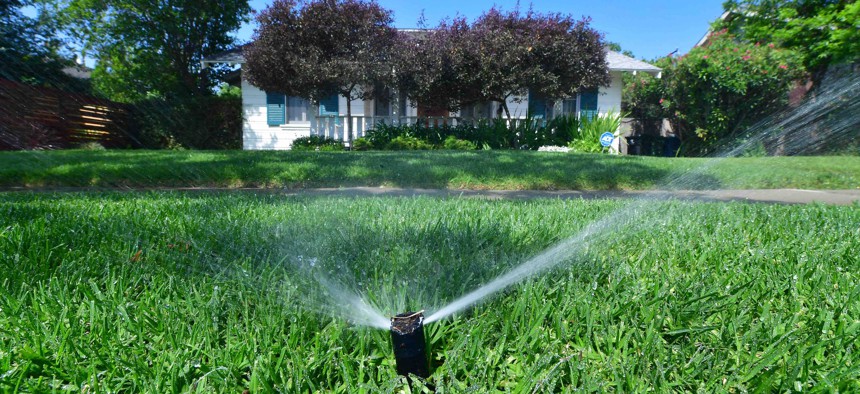6 Million in California Faced With Sharp Restrictions on Water Use

An automated sprinkler waters grass in front of homes in Alhambra, California on April 27, a day after Southern California declared a water shortage emergency with unprecedented new restrictions on outdoor watering for millions of people living in Los Angeles, San Bernardino and Ventura counties. Frederic J. Brown/AFP via Getty Images
Drought is draining reservoirs, again. “This is a crisis” said one official, adding: “We cannot afford green lawns.”
Water officials in southern California are imposing the most drastic cutbacks in municipal water use on record. They’re sharply restricting when people can water outdoor plants and lawns, as they look to reduce overall usage by 35% amid an unforgiving drought.
“This is a crisis. This is unprecedented. We have never done anything like this before,” said Adel Hagekhalil, the general manager of the Metropolitan Water District of Southern California, which is imposing the restrictions. “We don’t have enough water to meet the normal demands for the 6 million people living in the State Water Project dependent areas.”
Nearly half the country faces drought conditions right now, including most of the west, according to the federal government. Reservoirs across the region are falling, and the federal government is cutting the water output it sends to California, Arizona and Nevada from the Colorado River.
Scientists say climate change is fueling a megadrought through the Southwest that began in 2000 and is the worst in at least 1,200 years.
That leaves local officials with few easy options for managing the crisis.
In southern California, the Metropolitan Water District acts like a wholesaler that distributes water to local water utilities. It collects water from several sources, including the State Water Project, a 705-mile-long network of canals, pipelines and reservoirs that moves water from northern California to southern California. The Metropolitan district also ships water via aqueducts from the Colorado River on the eastern border of California to the Pacific coast. And the regional agency stores local water, too.
But all those supplies are coming up short this year. The first three months of 2022 were the driest on record for California. A promising winter for snowfall in the northern Sierra Nevada Mountains has literally evaporated with high temperatures. The snowpack went from 165% of normal levels in December to 38% of normal by April, Hagekhalil said.
The state responded by slashing the amount of water it promised to regional agencies, including the municipal district in southern California. The Metropolitan district will only receive 5% of its normal allotment of the water from the State Water Project, after receiving only 5% last year, too.
Now, the bad news is trickling down. The Metropolitan Water District’s board decided Tuesday to severely restrict usage for localities that depend heavily on northern California water.
The 6 million people in those areas will only be allowed to water their lawns one day a week, a big deal in a place where rain is scarce but the local greenery – from palm trees and parade-worthy roses to birds of paradise and bougainvillea vines – is legendary.
Half or more of Californians’ urban water is used outdoors, mostly for watering plants.
“We cannot afford green lawns,” Hagekhalil said at a press conference at Los Angeles’ Union Station on Wednesday. “We know many people are likely watering their yards more frequently than [once a week] and cutting back will hurt their yards. With one day a week, our lawns will get brown or yellow, but they will not die.”
“A lot of us like green lawns,” he said, “but now we’re facing the challenge between green lawns and our health and safety.”
The order gives local water utilities until June to impose watering restrictions. The utilities can either limit outdoor watering to one day a week or use a different mechanism to get equivalent reductions. The local agencies are also in charge of enforcing the new rules.
If the new restrictions don’t save as much water as planned, the Metropolitan Water District will ban all outdoor watering starting in September, officials said.
The 35% target for reducing water is the most ambitious goal in the Metropolitan Water District’s history. By comparison, then-Gov. Jerry Brown imposed 25% cuts for urban users in 2015 when he ordered the first statewide reductions in the state’s history.
Last month, Gov. Gavin Newsom pushed water suppliers to clamp down on water usage, but he stopped short of imposing statewide limits like Brown did.
Residential use is only part of what is putting pressure on the state’s water supply. California has a massive agricultural sector and roughly 80% of water used for businesses and homes in the state goes to irrigate crops.
In southern California, Hagekhalil stressed that the metropolitan agency has rebate programs and other incentives to help customers reduce their water usage by fixing leaky pipes, replacing broken toilets or planting drought-friendly plants instead of grass.
The new restrictions apply to people served by the Calleguas Municipal Water District, Inland Empire Utilities Agency, Las Virgenes Municipal Water District, Los Angeles Department of Water and Power, Three Valleys Municipal Water District, and Upper San Gabriel Valley Municipal Water District.
Daniel C. Vock is a senior reporter for Route Fifty based in Washington, D.C.
NEXT STORY: AWS launches digital twin service






